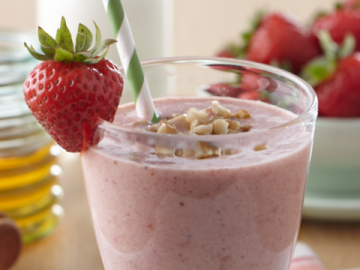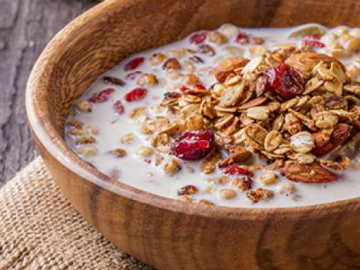Milk Vs. Oat Milk
Oat milk is the latest player in the non-dairy milk alternative world—joining other alternatives like almond, coconut and soy—and is a popular choice when served up as an oat milk latte. While oat milk’s consistency may be more similar to that of real dairy milk, it’s important to know that it’s not a one-for-one swap—especially when it comes to oat milk’s nutrition.
Oat Milk Nutrition vs. Real Dairy Milk: What’s the Difference?
One of the biggest and most important differences between oat milk’s nutrition and dairy milk is the nutrient profile. Oat milk provides fewer nutrients than dairy milk, and most of the nutrients it provides are fortified. That means they’re added during manufacturing, as opposed to occurring naturally.
Specifically, dairy milk provides 13 essential nutrients in each 8-ounce glass (protein, calcium, vitamin D, vitamin A, phosphorus, vitamin B 12, riboflavin, pantothenic acid, niacin, zinc, iodine, selenium, and potassium); a glass of original oat milk has five (calcium, vitamin D, vitamin A, riboflavin and iron). Apart from iron, all of the nutrients in oat milk are fortified. While dairy milk is fortified with vitamins A and D, the rest of its nutrients occur naturally, making it a naturally nutrient-rich choice.
Apart from providing more nutrients overall, dairy milk also has about twice the protein as oat milk. Protein is important to consider when choosing foods and beverages, as it helps build lean muscle, and getting enough at each meal can help you feel full and satisfied. Dairy milk provides 8 grams of protein in every 8-ounce glass, while the same amount of oat milk typically provides 4 grams (though the protein in oat milk varies from brand to brand, so it’s important to check the label). Dairy milk is also a source of complete, high-quality protein, which means every glass contains a full mix of essential amino acids. Most plant-based protein sources, like oats, are incomplete proteins and missing some of the essential amino acids our body needs.
Dairy milk provides 8 grams of protein in every 8-ounce glass, while the same amount of oat milk typically provides 4 grams.
Real dairy milk also boasts a simple ingredient list—just milk, vitamin A and vitamin D—so you always know what you’re getting when you reach for a glass. Oat milk can vary considerably from brand to brand, in both nutrients and ingredients. Fortification of non-dairy milk alternatives is not federally regulated, so some brands may fortify more while others fortify less. And when it comes to ingredients, some varieties of oat milk have more than ten, including stabilizers and emulsifiers like gellan gum, locust bean gum and sunflower lecithin. That’s why it’s important to read and compare nutrition labels and ingredient lists to make a well-informed choice.
Oat milk and dairy milk also differ in carbohydrate content. Original varieties of oat milk can have up to 24 grams of carbohydrates per serving, while dairy milk has 12 grams. Some varieties of oat milk also contain added sugar. The Dietary Guidelines for Americans recommends limiting the amount of added sugar in your diet, and the good news for milk lovers is that regular white dairy milk has no added sugar at all. The sugar in white milk is lactose, which is naturally occurring.
Here’s a closer look at how 8 ounces of low-fat (1%) milk compares to a standard original oat milk when it comes to nutrition[i]:
Lowfat Milk
- Calories: 100
- Protein: 8g
- Fat: 2.5g
- Carbohydrates: 12g
- Total Sugar: 12g
- Nutrients*: calcium (30%), vitamin D (30%)*, phosphorus (25%), riboflavin (25%), vitamin B12 (20%), protein (16%), vitamin A (10%)*, potassium (10%), niacin (10%)**
- Ingredients: Milk, vitamin A, vitamin D
Original Oat Milk
- Calories: 130
- Protein: 4g
- Fat: 2.5g
- Carbohydrates: 24g
- Total Sugar: 19g
- Nutrients*: calcium (35%)*, vitamin D (25%)*, riboflavin (30%)*, vitamin A (10%)*, iron (10%)
- Ingredients: Water, oats, oat bran, tricalcium phosphate, sea salt, gellan gum, vitamin D, riboflavin, vitamin A
- †Nutrients signify food provides 10% or greater of the Daily Value of labeled nutrients. Nutrients will differ by brand, flavor and fat content as nutrient fortification varies.
- ††Product formulation will differ by brand, flavor and fat content, so ingredients may vary.
- *Indicates nutrient is fortified.
- **As niacin equivalents.
And, at just about a quarter per glass, dairy milk is a more affordable option than oat milk, which is about $0.86 per glass, and other non-dairy milk alternatives, making it an easy way to get more nutritional bang for your buck.[ii]
Understanding Your Options
Real dairy milk is one of the original farm-to-table foods and is wholesome, minimally processed and naturally nutrient-rich. It provides B vitamins for energy, high-quality protein for lean muscle, vitamin A for a healthy immune system and other bone-building nutrients, including calcium and vitamin D. Few non-dairy milk alternatives can match its full nutrient package.
Dairy milk also offers a range of health benefits backed by decades of research. In fact, “intake of dairy products is also associated with a reduced risk of cardiovascular disease and type 2 diabetes, and with lower blood pressure in adults,” according to ChooseMyPlate.gov. The nutritional impact of non-dairy alternatives, on the other hand, has not been thoroughly studied.
So, the next time you’re deciding what to request in your latte or pick up at the store, remember non-dairy milk alternatives don’t offer the same nutrition benefits, functionality or taste as real dairy milk. Understanding your choices and the differences between them can help you determine the most suitable beverage for you and your family.
Freezing Milk
If you want to save milk for later, you can—just freeze it in small containers (or an ice cube tray) before the expiration date. You’ll notice that milk (and oat milk as well) separates, and that’s completely normal. When you’re ready to use it, let it thaw in the refrigerator. Be sure to give it a quick shake and it’s ready to drink or use in your favorite recipes. If you want to save time in the morning, those frozen milk cubes have many uses, including adding them to your cold-brew iced coffee and smoothie recipes.
- [i] U.S. Department of Agriculture, Agricultural Research Service. 2015. National Nutrient Database for Standard Reference, 1 Release April, 2018. USDA #01082; Milk, lowfat, fluid 1% milkfat, with added vitamin A and vitamin D; USDA #45237486; ORGANIC OAT BEVERAGE, UPC: 052603065702.
- [ii] Sales data from IRI calendar year 2018, and average online grocery prices for top markets.




